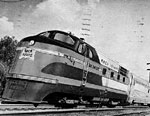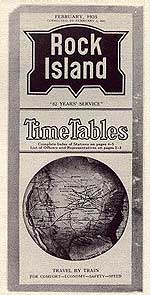By Jim Bickal
Minnesota Public Radio
October 15, 2002
| |
|
|
|
||
The first permanent resident of Rock Island was George Davenport, who was brought in by the Army in 1816 to acquire supplies for the fort.
Davenport became a very successful entrepreneur and helped establish several towns including Davenport, Iowa in 1839. He was also involved in the effort to improve the country's transportation links. In the early part of the 19th century, most of those improvements involved making rivers easier to navigate or digging canals. But Davenport saw the potential of a transportation system that wasn't restricted to waterways.
"I think George had a vision of the railroad very early on. The railroad was not a fashionable project until after the Panic of 1837. And then suddenly the canals, which had been such a rage, mainly because of the Erie Canal, sort of lost favor. Finally people realized that they required a great deal of maintenance and a lot of money in order to make them worthwhile. And so I think he was looking at the railroad very early on as something that would get them away from being bound by the rivers," says historian Gena Shantz.
In 1845, Davenport invited a group of local businessmen to his home on Rock Island to discuss a investing in a project that would link the Mississippi River with the Great Lakes for the first time, a railroad from Rock Island to Chicago. The men embraced the idea, but Davenport would not live to see it become reality. One month after that meeting, on Sunday, July 4th, George decided to skip church. Unfortunately for him, it was a day thieves had picked to rob his house.
"They knew that on the Fourth of July the family would be going to the Sabbath Day celebrations and would be gone for the whole day," says Shantz. "What they didn't realize was that George stayed home that day. So when they broke into the house they found him in his sitting room. A gun that they had accidentally went off, shot him in the thigh. George lived a few hours into the evening and then he died of probably shock and blood loss."
|
"One analogy would be about like the dot-com industry. Everybody was going to build a railroad from here to there and do a better job of it." - Al Zimmer, railroad historian
|
The death of George Davenport didn't stop the Rock Island Line. A charter was approved by the Illinois Legislature in 1847 and the first train ran on Oct. 10, 1852. By that time, just about anybody with a few bucks to spare was looking to get into the railroad business.
"One analogy would be about like the dot-com industry. Everybody was going to build a railroad from here to there and do a better job of it," says Al Zimmer, a student of railroad history and the Rock Island Line in particular. "There were an awful lot of railroads that were planned that never built more than a couple miles or didn't do anything except raise some money."
The Rock Island Line survived the early volatile years of the railroad era in part because it was the first railroad to send a train across the Mississippi River. In the 1850s, building a river bridge that could support the weight of a train was a challenge, but Zimmer says it was a little easier for this railroad because of Rock Island.
"The easiest place to build it was to make a stop there on the Rock Island, island in the middle of the river and go on to Iowa. Sort of a hop, skip and a jump across the river you might say," according to Zimmer.
In April 1856, a two-part bridge, with Rock Island in the middle, was completed, and for the first time trains were able to cross the Mississippi River and bring crops from the farm fields of Iowa directly to Chicago and the Great Lakes.
| |
|
|
|
||
But just one month after the bridge opened, a steamboat named the Effie Afton was traveling up the river from St. Louis on its way to St. Paul. Exactly what happened when the Effie Afton reached the Rock Island Bridge is a local mystery.
"While it was passing under the bridge, for some reason or another, it got twisted around, hit the piers on the bridge. Of course, they had lanterns and kerosene lamps and things like this and the bridge caught fire. There was a lot of damage done to the bridge and it took an extended period to restore it. Even at the time that the incident occurred, there was much speculation in the local newspapers as to whether it was an accident or an intentional arson, let us say."
The speculation was that the steamboat owners wanted the bridge to burn because the railroads were taking away their customers. The arson charge was never proven, but the owners of the Effie Afton did sue the Rock Island Bridge Company, charging that the bridge was a hindrance to navigation and should be torn down. In addition, the steamboat interests asked the court to prohibit all future bridges on the river.
To protect their interests the Rock Island Railroad hired an Illinois lawyer by the name of Abraham Lincoln.
"Lincoln was widely known in the 1850s as a very prominent attorney in the state of Illinois and he was beginning to specialize in railroad litigation," according to John Lupton, an editor with the Lincoln Legal Papers, a project that is chronicling Abraham Lincoln's 25-year legal career. "He had handled numerous cases for the Illinois Central Railroad and he also had a number of cases on the opposite side of railroads. He personally saw that railroads were an important contribution to the transformation of America from a subsistence economy to a market economy."
Lupton says one of the things that made Lincoln a good lawyer was how well he prepared for a case. "Lincoln was what you would call a case lawyer, which means he studied really hard when a case came before him. So when this came before him, he actually went to Rock Island itself and did some examination there of the bridge and how the water was flowing between the piers and this was very typical of Lincoln preparing for a case. He was a very slow and methodical thinker."
| |
|
|
|
||
When he went to Rock Island, Lincoln examined the bridge and the river and took some of his own measurements. He studied a survey of the rapids near the bridge completed in 1837 by Lt. Robert E. Lee of the U.S. Army Corps of Engineers.
At the trial, Lincoln made a strong case that the boat was at fault -- not the bridge -- and that steamboats and railroads could share the river. In his closing argument he talked about the importance of rail to the future of America. He said, "It is growing larger and larger, building up new countries with a rapidity never before seen in the history of the world."
The trial ended in a hung jury which meant that the bridge could stay. It was a victory for the Rock Island Railroad and for Lincoln. His work on that case and others would help put him in a position to run for President three years later.
"I think another reason why he wanted to get involved with this case is that he saw that there was a lot of money to be made there," says Lupton. "When you're dealing with entire business interests competing against each other, there's going to be a lot of money going into battling in these lawsuits and Lincoln saw it as a way to make a little tidy sum for himself. He had spent most of 1856 campaigning for the Republican Party, which takes him away from his legal business so he saw this as a way to kind of fill his coffers back up."
As president, Lincoln pushed for completion of a transcontinental railroad and when it was done in 1869, the Rock Island Line was one of the links connecting the East and West Coasts for the first time. It also played a prominent role in the story of the west. It was the first railroad to be robbed by the Jesse James gang and it lost a depot in the Great Chicago Fire of 1871.
Despite those setbacks, it continued to grow, and brought many of the first settlers to the newly open Territory of Oklahoma in 1889. By the beginning of the 20th century, the Rock Island Line was one of the most successful railroads in the western half of the country with service in 14 states. The last state to become part of the line was Arkansas and it was here that it inspired a song.
Around the beginning of the 20th century, the Rock Island Railroad was taken over by a group of speculators who attempted to make some money through rapid expansion.
The new construction and acquisitions put the railroad deeply in debt. It went in and out of bankruptcy twice between 1915 and 1948. By the 1950s, passenger traffic was already declining as a growing number of people chose to ride in cars or on airplanes.
In 1971, other railroads were able to transfer their unprofitable passenger lines to Amtrak, but railroad historian Al Zimmer says the Rock Island couldn't afford to do that and federal law required them to continue providing passenger service that they were losing money on.
"The railroads couldn't just say 'I want to get rid of it, you take it.' They had to buy their way in and the Rock Island could never come up with the money that Amtrak wanted to take over its passenger trains. So even after Amtrak started in 1971, they kept running the Rock Island-Chicago route, and the same with Peoria. And those finished up in November of '78. They were down basically to two cars and a beat up locomotive," Zimmer says.
The Rock Island tried to work out a merger with the Union Pacific but the deal was held up by federal regulators. The railroad finally went under after its clerks went on strike in 1979. The last train ran on Mar. 31, 1980. Its assets were eventually auctioned off.



